Duck hunting is absolutely amazing as long as you have one thing, ducks. No matter what species you are hunting, the sight of a group of ducks cupping into your decoys is enough to give you chills. With that being said, trying to harvest a particular type of duck can add a whole new layer to the excitement of your hunt. Just about every duck hunter has harvested mallards or wood ducks, but if you want to change things up a bit, where do you find the “rare” ducks? If you even want to have a chance at harvesting some of these rare ducks, you have to travel far and wide during the harshest times of winter, but the reward is well worth the effort. Here is a breakdown of fourteen rare duck species (in no particular order) and where you can find them:
1| Cinnamon Teal
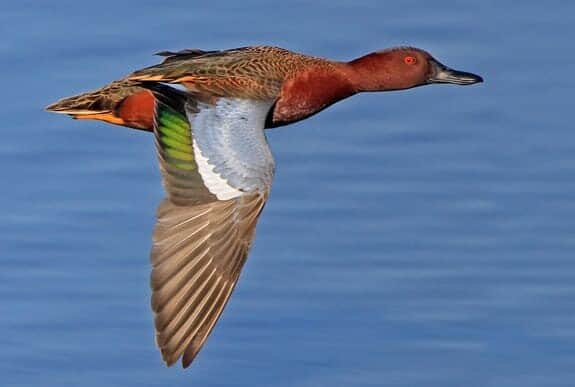
Description:
Male Cinnamon Teals have a cinnamon-red colored head and breast. They also have an iridescent green speculum, that is separated from a bluish shoulder patch by a white stripe. The back and tail are a dull brown color, and their undertail coverts are black. The female Cinnamon Teal looks a lot like the female blue-winged teal. They have a darker blue shoulder patch and overall more rust-like color. Like other teal, they are quite small. Cinnamon Teal can reach around 15 inches in length and weigh around 0.7 pounds. They are also one of the smaller dabbling ducks, feeding mainly on seeds and aquatic plant life. Cinnamon Teals are a bit rare in the United States, with a population of around 100,000-300,000. After their fall migration, many of them come up from Mexico, increasing the United State’s cinnamon teal population to around 500,000.
Where to Find Cinnamon Teal:
Cinnamon Teal are mostly found on the West Coast and Midwest of the United States and throughout Mexico. During the winter, nearly all of them will migrate to Mexico or even as far as Peru and other parts of South America. Generally, you can find Cinnamon Teal in small ponds, and shallow wetlands or marshes. They mainly breed in the western United States near the Great lakes.
2| Barrows Goldeneye
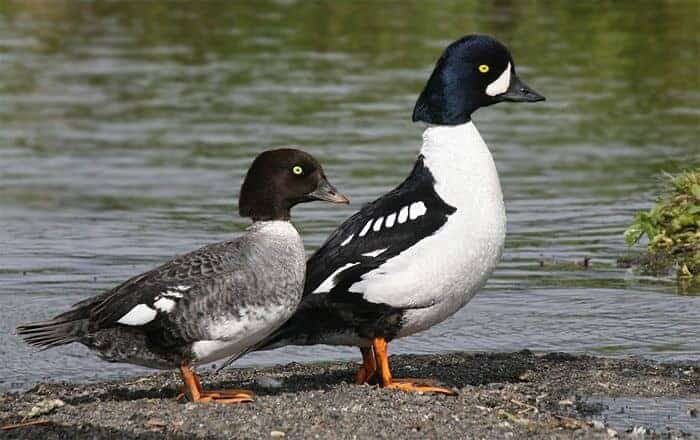
Description:
Barrows Goldeneye has a puffy, oval-shaped, purplish head, with a crescent-shaped white patch between their black triangular bill and yellow/golden eyes. Their neck and body are mostly white, and their back and wings are black with a row of white spots along the wing. They also have yellowish feet. The female Barrow’s Goldeneye has a dark brown head with a whitish collar. The back and sides are gray and the chest, breast, and belly are white. The bill is orangish with a blackish nasal area and tip. Barrow’s Goldeneye gets up to about 19 inches long and weighs about 2.1 pounds. These ducks are diver ducks that mainly feed on small fish, crustaceans, and aquatic insects. Their population size is smaller than most, ranging from around 150,000 to 200,000 individuals.
Where to Find Barrow’s Goldeneye:
Barrows Goldeneye mostly resides in Alaska, the North West United States, and parts of Canada. Although they have been known to rarely travel as far east as South Carolina. Typically they migrate west to Alaska or the west coast. They can be found on lakes, rivers, and bays.
3| Black Ducks

Description:
The American Black Duck is just that, black. Its head is a lighter shade of brown, and they have a beautiful blue speculum. The Black Duck at a glance looks remarkably like the female mallard. As a matter of fact, my father and I had harvested at least half a dozen Black Ducks before we ever realized what they were. To tell them apart, the easiest characteristic to notice is their bill. Black Duck males will have yellow bills, females will have dull almost black bills, while hen mallards will have orange bills. Their size is also similar to mallards, they reach around 22 inches in length and weigh around 2.5 pounds. Black Ducks are puddling ducks that feed on seeds and aquatic plants, again much like a mallard. Black Duck population numbers have been decreasing for years, partly due to loss of habitat, and fierce competition from mallards. Their numbers are currently estimated to be around 275,000.
Here I am in 2018 with an American Black duck I harvested in North Georgia.
Where to Find Black Ducks:
American Black Ducks are typically found in the North-East portion of North America, although they migrate to the South East portion of the United States during the winter. They occupy the same types of waters as mallards. They can be found in swamps, wetlands, ponds, and even lakes. Black Duck-Mallard hybridizations are also commonly found throughout the same territory.
4| Silver Teal
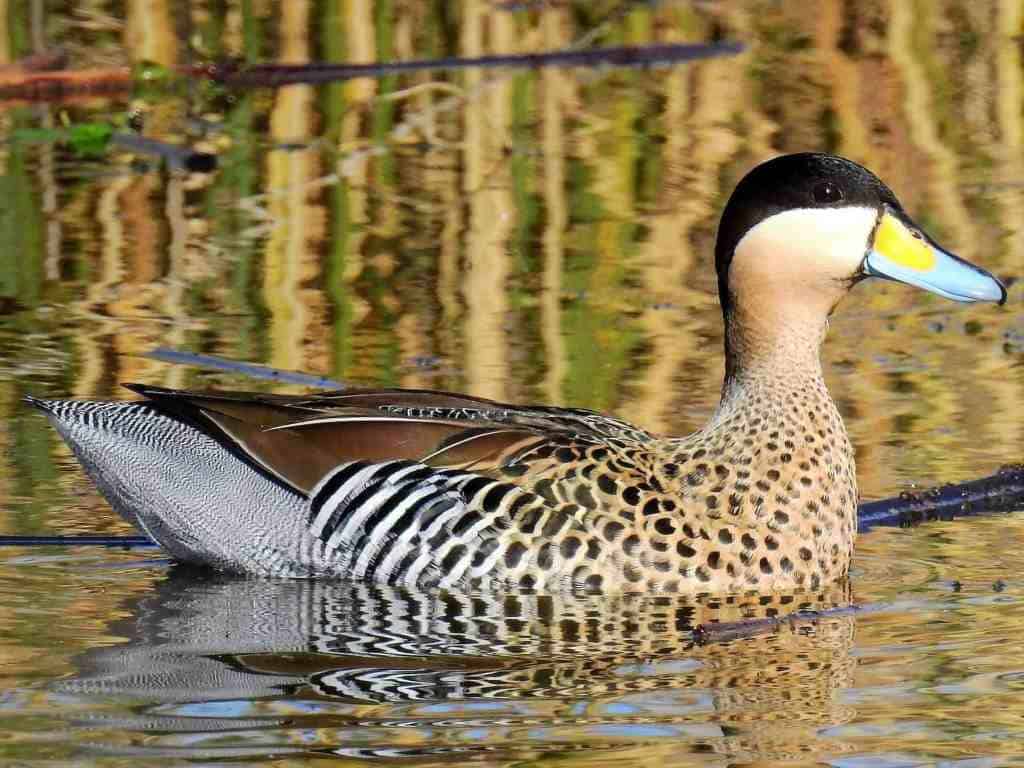
Description:
The Silver Teal is a colorful little dabbling duck. The top of his head is black, and just under the eye, it turns to a brownish white. The neck and check have the same brownish-white color. The body feathers have small black and white stripes. Silver teal also have a green speculum with a white border. On the back half, the silver teal has the same black and white strips but at a higher frequency. It almost looks like a solid color until you get close enough to see the stripes. His bill is a yellow color with a blue outline. The size of a Silver Teal is close to that of a wood duck. They are about 15 inches long and weigh approximately 11 ounces. Silver Teal are considered dabbling ducks and feed on seeds and aquatic plants. Their population ranges between 50,000 and 100,000 birds between the two subspecies. Their numbers are quite low compared to most birds on this list.
Where to Find Silver Teal:
Silver Teal resides in South America. Their ranges are across southern Bolivia, southern Brazil, Paraguay, Argentina, Chile, Uruguay, South Georgia, South Sandwich Islands, and the Falkland Islands. The southernmost birds migrate to southern Brazil in the winter. This can make it quite difficult for Americans to go after these beautiful ducks, but if you are determined to add one of these to your bucket list, you will not be disappointed.
5| King Eider
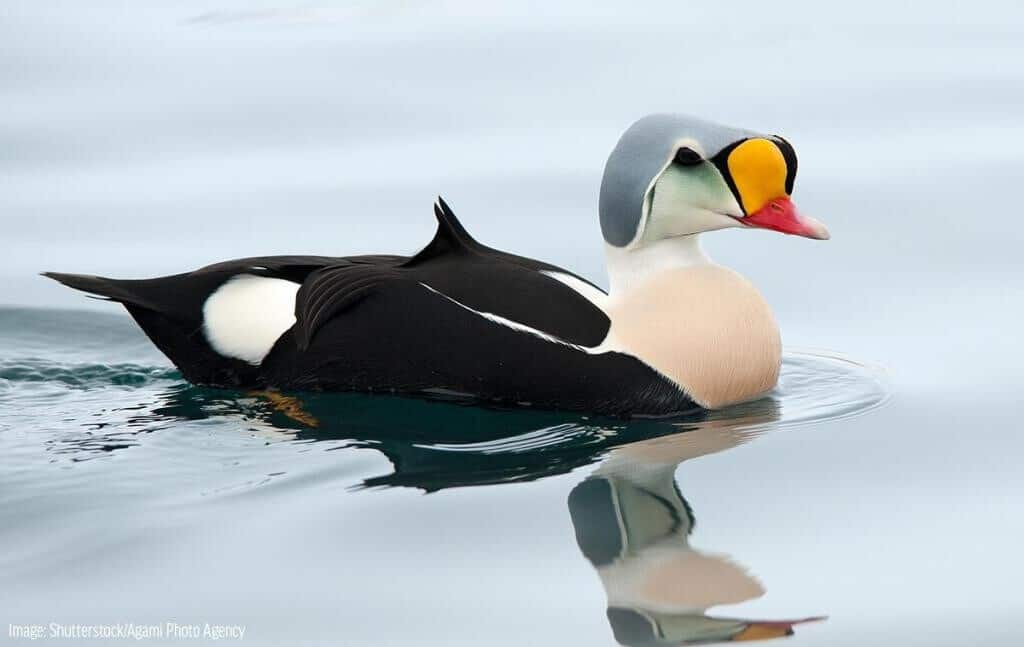
Description:
King Eiders have an easily recognizable yellow frontal shield outlined in black. Their bills are orange, as well as their feet. Most of their body is black with the exception of their heads, neck, breast, and foreback. Female King Eiders are a tawny-brown color and look very similar to common Eider females. King Eiders are diving ducks, they are known to eat mollusks, crustaceans, aquatic insects, eelgrass, widgeon grass, and algae. These ducks are known to dive to depths of well over 100 feet to get to these different types of food. These ducks are also quite large, they are around 22 inches in length and weigh around 3.6 pounds. In the 1990s, the population of King Eiders was estimated to be around 375,000, although observations of migrating populations in Alaska suggest that their population has decreased by over 50% since then.
Where to King Eiders:
King Eiders live along the coasts. In North America, they are found around the Alaskan coast and follow the Canadian coast all the way to Greenland. Although they are known to travel south during their migratory period, they do not travel very far. Most of the population stays close to the coasts of Alaska and Greenland, but small populations have been sighted on the northern coasts of California and Florida.
6| Ruddy Duck
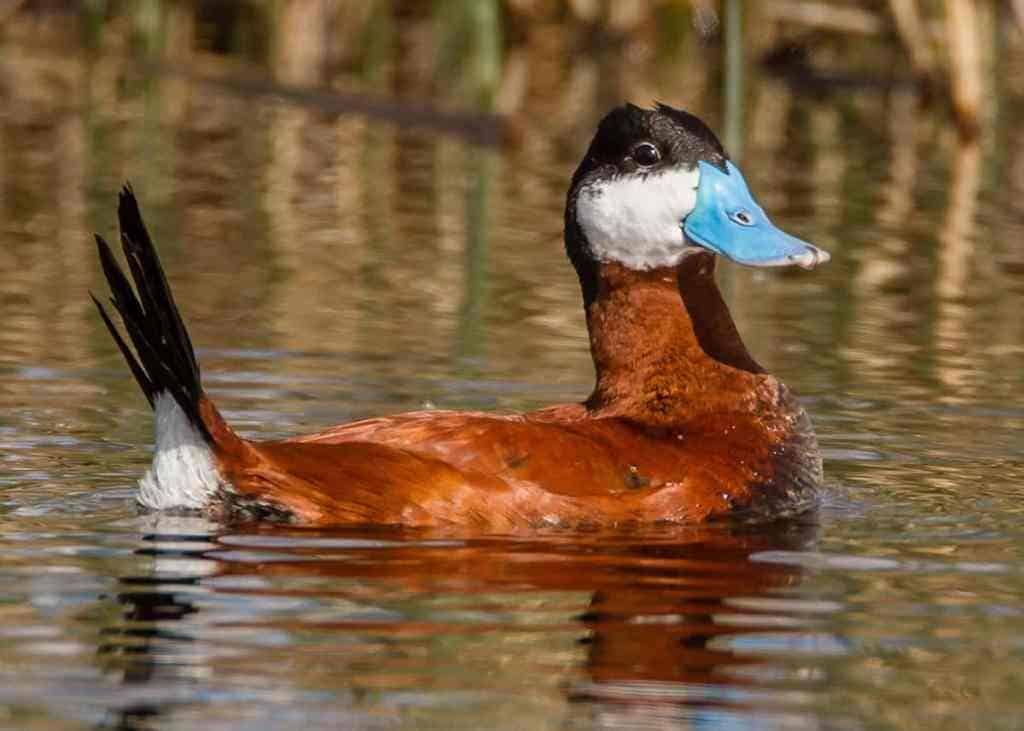
Description:
Although I have never harvested one, the Ruddy Duck is honestly one of my favorites on this list just based on looks alone. He has a black cap that goes down his neck, his face is white as well as the front of his neck. However, his bill is a beautiful bright blue. His body is a rusty brown and his fan-shaped tail has stiff black feathers that are very distinctive. Female Ruddy Ducks are mostly brown all over, with some lighter brown markings around the face. Sadly, females do not share the same flashy blue bill as males, but instead, they have a brownish-black bill. Ruddy Ducks can reach about 15 inches long and weigh 1.2 pounds on average. For food, these ducks dive down to feed on pond weeds and other aquatic plants. Between the three subspecies of Ruddy Duck, their total population hovers around 750,000 individuals. This duck is definitely on my hit-list!
Where to Find Ruddy Ducks:
Ruddy Ducks are found around most of North America but about 50% of them winter in Mexico, and the other 50% normally split up between the east coast of the United States and the interior wetlands of the southern states. Typically the Ruddy Duck can be found in marshes, lakes, rivers, and coastal areas near the areas mentioned previously.
7| White-Cheeked Pintail
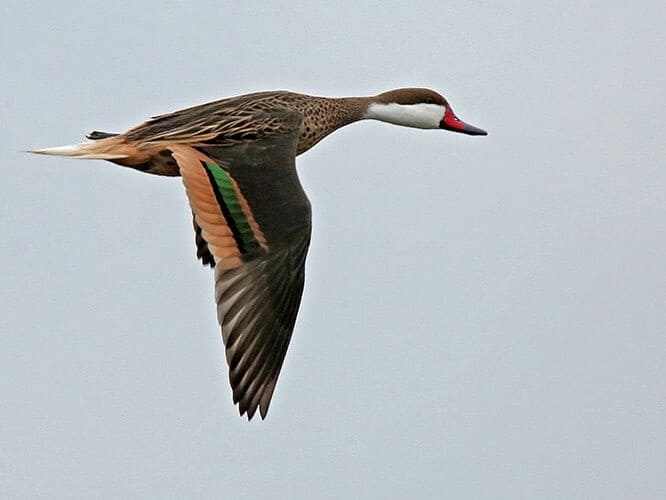
Description:
The White-Cheeked Pintail obviously has a bright white patch on his cheeks. Most of his body is a dapple brown color. He is made up of a light and dark brown color pallet. His bill is black with a beautiful red patch near the nasal area. Their speculum is bright green surrounded by a khaki brown. The female of this breed does not have a white cheek and she also has a blue speculum instead of green. The White-Cheeked Pintail has classic pin-shaped tail feathers that are a bright white. They are around 17 inches long and can weigh around 1.1 pounds. The White-Cheeked Pintail is also a dabbling duck that feeds on seeds and aquatic plants. Their population ranges from around 75,000 to 100,000 birds, which is fairly low compared to most ducks.
Where to Find White-cheeked Pintails:
These dabbling ducks are found in the Caribbean, South America, and the Galápagos Islands. They are rarely seen as far north as the United States, but if you can make the trip to the Caribbean these ducks are beautiful spectacles that would be the centerpiece of any hunters trophy room.
8| Common Eider
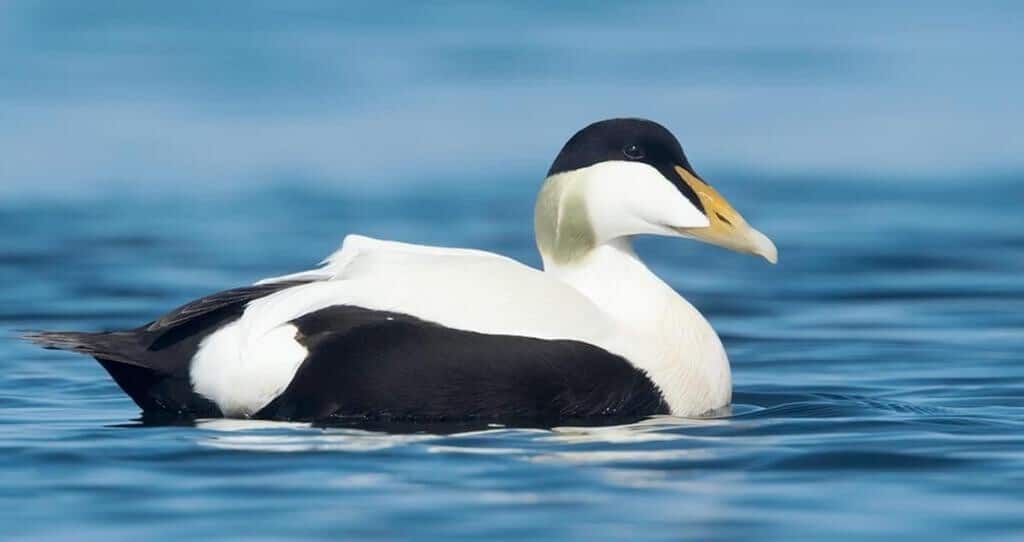
Description:
The Common Eider is the largest duck in North America. They reach up to 24 inches long and 4.3 pounds! They are fairly stocky and thick ducks. Common Eiders have a black hood with a yellow patch just above their orange bills. The top half of this duck is white, while the breast, belly, wingtips, and rear-end are black. Like the King Eider, these ducks live on the coasts and are diving ducks, so they mainly eat small fish and crustaceans. In North America, their numbers are in a general decline due to a lack of quality food, but they are currently estimated to have a population of 150,000 to 300,000.
Where to Find Common Eiders:
These ducks live on the coasts of the top of North America. They mostly live along the coasts of Alaska, all the way around to the coasts of Greenland. They are frequently seen along Canadian waters and have been seen as far south as the coast of Virginia. Common Eiders are beautiful ducks and are a trophy to any hunter.
9| Northern Pintail
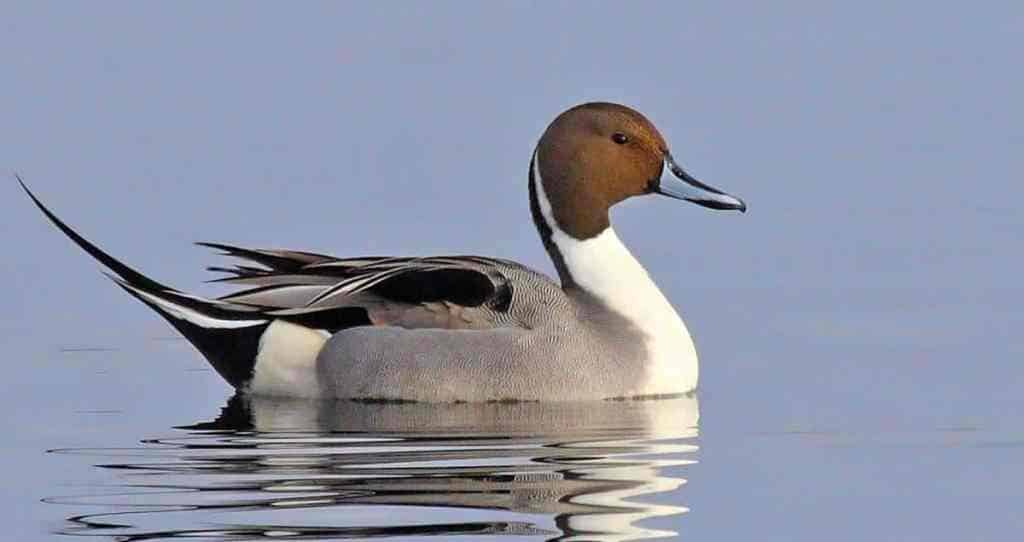
Description:
Northern Pintails are slender ducks with an elongated white central tail feather that makes up ¼ of their overall length. They have chocolate brown heads with a white stripe down both sides of their heads. Their neck, breast, and bellies are an off white color. While their speculum is a rich green color. Their top half is grey and black, as is their bill, and their legs. The Northern Pintail reaches around 25 inches in length and about 2.25 pounds. They are dabbling ducks that mostly feed on seeds and aquatic plants. Their population is currently estimated to be a healthy 3.2 million birds.
Where to Find Northern Pintail:
Typically the Northern Pintail is known to occupy the North and West parts of North America during most of the year. These birds can be found in wetlands, marshes, and occasionally in flooded fields. During their migratory period, these ducks are known to migrate to the Southern parts of North America and typically do not go much further south than Mexico. Nearly all southern states in the USA will have populations of Northern Pintails during the winter.
10| Harlequin Ducks
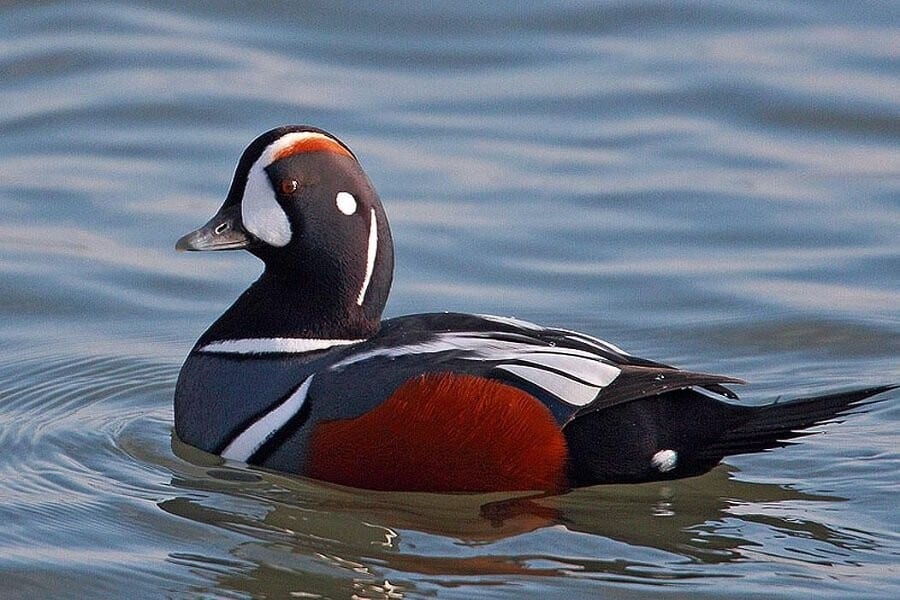
Description:
The Harlequin is a very uniquely colored duck and is not easily confused with any other species. They are mainly a deep blue almost greyish black color. They have rustic brown patches on the top of their head, and on their sides and wings, with white markings all over their body. Harlequins reach around 14 inches in length and 1.3 pounds. They are diving ducks that mainly feed on crustaceans, mollusks, insects, and small fish. The Pacific Harlequin population is at over a healthy 1 million birds, although the Atlantic Harlequin population is considered to be made up of less than 25,000 birds.
Where to Find Harlequin Ducks:
The majority of these ducks are known to live off the coast of western Canada and Alaska. There are also populations along the coast of Greenland, northern Quebec, and Newfoundland. They can normally be found along coasts or fast-flowing rivers close to the areas mentioned. During their migratory season, they do tend to travel south but not very far. Harlequins have been spotted as far south as central California on the west coast, and Maryland on the east coast.
11| Canvasback
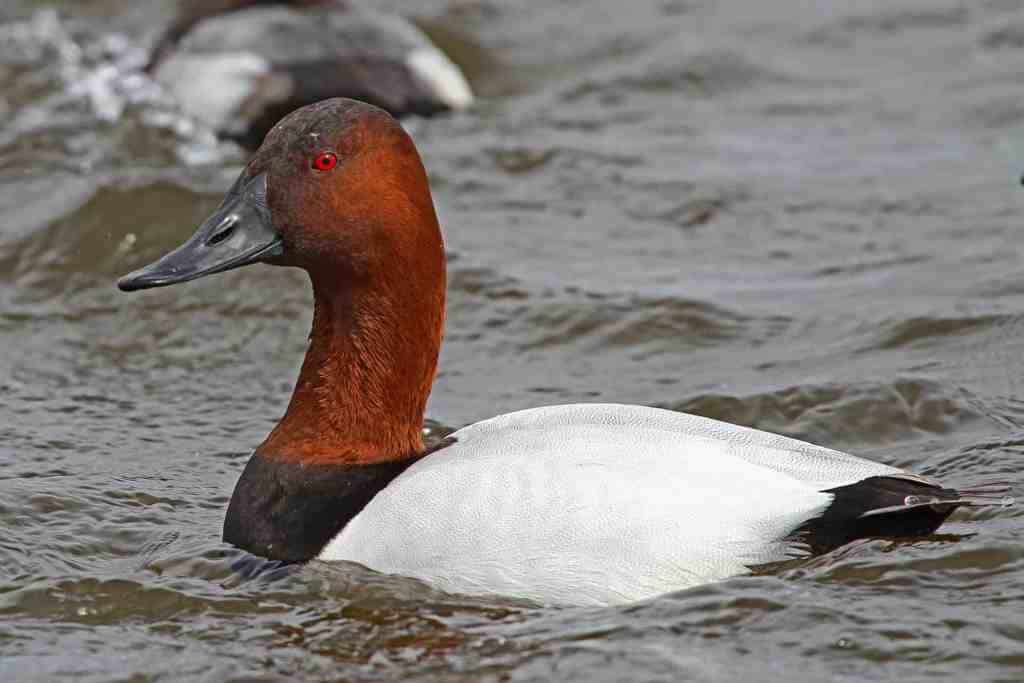
Description:
The Canvasback has a brown head with a black neck and mostly white body. They have very recognizable red eyes, although that is only the case in males. The Canvasback also has a black bill and black feet. They are suitably named “canvasback” because of their solid white backs that look like a blank canvas. They reach around 21 inches in length and weigh around 2.5 pounds. Canvasbacks are freshwater diving ducks that eat everything from seeds to plant tubers and from mussels to insects. Canvasbacks suffered huge losses from the lead shot pandemic, thousands of these birds died from lead poisoning in the 1980s and 90s. After the lead shot band, their population has been rebounding in the past few decades but their numbers currently hover around 700,000 birds.
Where to Find Canvasbacks:
During the breeding season, Canvasbacks are mostly found in eastern Canada and Alaska, although some populations can be seen in the Northern United States. After they migrate, Canvasbacks live in the southern United States and Mexico. During all times of the year, they prefer to be in small lakes, deep-water marshes, bays, and ponds.
12| Red-Breasted Merganser
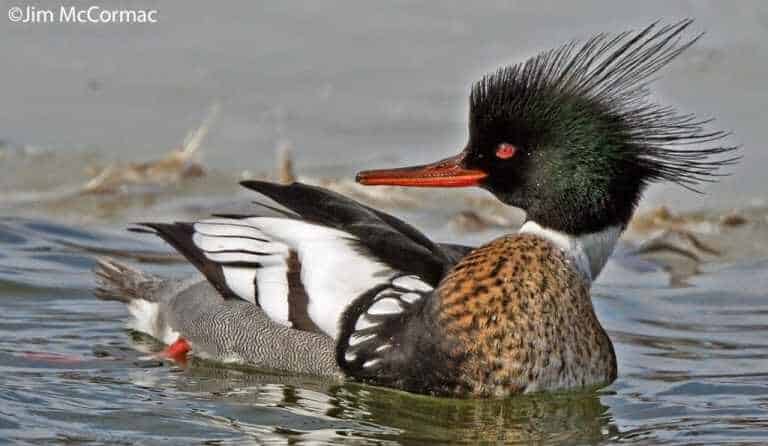
Description:
Funny enough, the Red-Breasted Merganser does not have a “red” breast. They have a light brown neck that goes down to the top of the breast, but most of the breast is actually white. They do, however, have red eyes and a blackish-green head. Red-Breasted Mergansers also have a few Alfalfa type feathers off the back and one top of their heads that stick right out. Most of their body is a greyish-white color, while their wings are black and white. They can reach lengths of about 17 inches and weigh around 1.5 pounds. Red-Breasted Mergansers are diving ducks that feed on small fish, and occasionally crustaceans. Since the 1980s the Red-Breasted Merganser population has been declining. Their numbers now hover around 375,000 which is about 15% less than it was in 1980.
Where to Find Red-Breasted Mergansers:
During the breeding season, Red-Breasted Mergansers are found in northern Canada and all of Alaska. When they migrate during the winter, they fly to the coasts. Which coasts? All of them! They nearly outline all of North America, from Alaska to Mexico, and from Greenland to Florida. These birds prefer to be around deeper waters, like lakes, bays, coasts, or The Gulf of Mexico.
13| Black-Bellied Whistling Duck
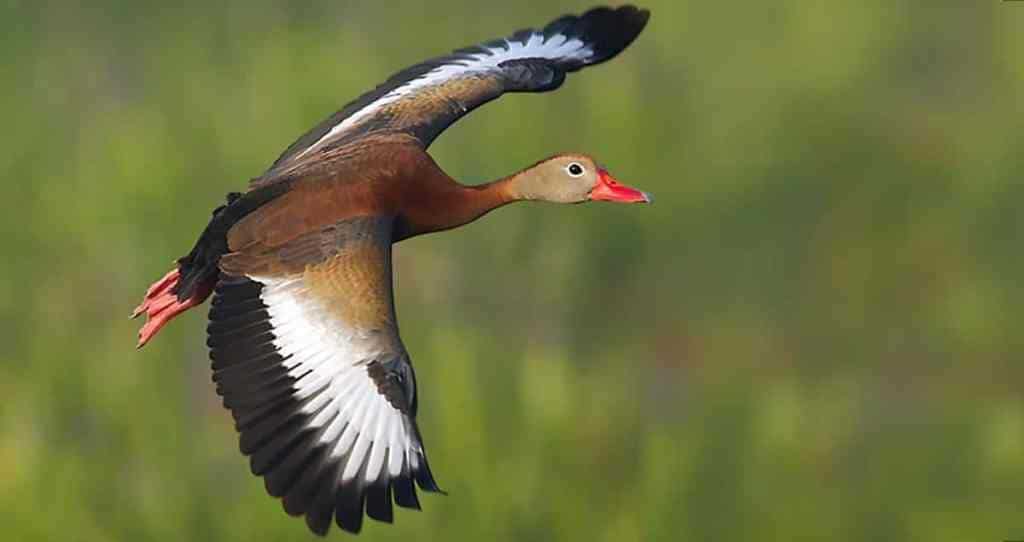
Description:
These lanky ducks have a brown head with a dark stripe down the back and an orange bill. Their neck and breast are a light brown color, while their bellies are, as the name would suggest, black. Their wings are also light brown on top but turn to black on the underside. Males
and females of this species are nearly identical in size and color. Black-Bellied Whistling Ducks can get up to about 19 inches long and weigh around 1.8 pounds. They are commonly found around wetlands near the coast where they prefer to be perched in a tree. These ducks uniquely feed at night on grains and other wetland aquatic plants. Their population is doing well, there are estimated to be 1.1 to 2 million Black-Bellied Whistling Ducks living in North America.
Where to Find Black-Bellied Whistling Ducks:
These ducks are mostly found around the coasts of Mexico, and up the coasts of the Gulf of Mexico. That being said, if you want to harvest a Black-Bellied Whistling Duck in the United States, you can find populations of them in southern Texas and in most of Florida.
14| Long-Tailed Duck
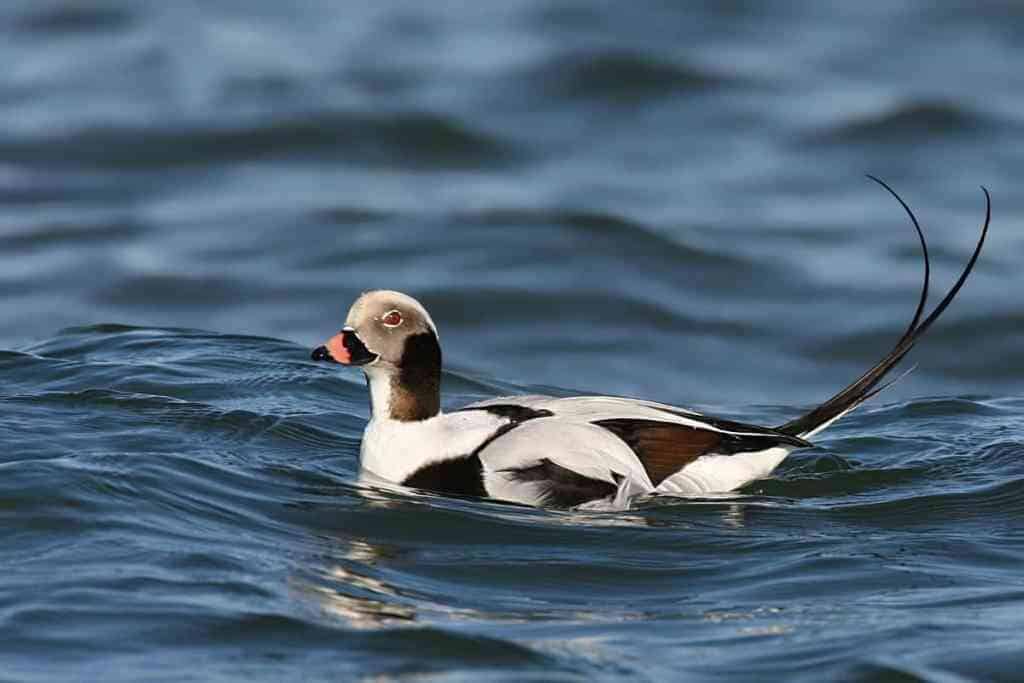
Description:
These ducks are one of the most uniquely colored ducks on this list. They have white and grey heads with a patch of black and brown just under the cheek. Although during the breeding season these colors are reversed on the head. Their necks are white, and their breasts are black. Most of their back half is white, except for the wings which share some black and white markings. The most noticeable thing about this duck is its considerably long tail. Its central tail feathers are black and make up a large portion of its overall length. Speaking of length, these birds get to about 19 inches long and can weigh about 2 pounds. They are one of the smaller diver ducks, but they are still very successful in their dives for mollusks and crustaceans. Currently, their population is considered to be a healthy one million birds.
Where to Find Long-Tailed Ducks:
These ducks are exclusively found in the northern half of North America. They stay on the coastlines and pretty much outline North America starting from Northern California, and wrapping all the way around to North Carolina.
Thank you for reading my article about rare ducks and where to find them. I hope you enjoyed it and learned something you didn’t already know. If you like my content, subscribe to my weekly update. If you have any other questions about these rare duck species or just want to connect, feel free to email me at [email protected].

